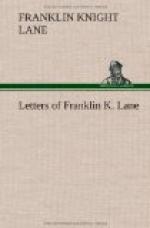“On the last day but one of this visitation the fire, smoldering slowly in the redwood houses, had taken virtually all the district east of Van Ness Avenue, a broad street which bisects the residence quarter. ... By this time the authorities had given up dynamiting. Chief Sullivan, the one man among them who understood the use of explosives in fire fighting, was dead. The work had been done by soldiers from the Presidio, who blew up buildings too close to the flames and so only scattered them. Lane stood on the slope of Russian Hill, watching the fire approach Van Ness Avenue, when a contractor named Anderson came along. ’That fire always catches at the eaves, not the foundations,’ said Lane. ’It could be stopped right here if some one would dynamite all the block beyond Van Ness Avenue. It could never jump across a strip so broad.’ ‘But they’ve forbidden any more dynamiting,’ said Anderson. ’Never mind; I’d take the chance myself if we could get any explosive,’ replied Lane. ’Well, there’s a launch full of dynamite from Contra Costa County lying right now at Meigs’s Wharf,’ said Anderson. Just then Mr. and Mrs. Tom Magee arrived, driving an automobile on the wheel rims. Lane despatched them to Meigs’s Wharf for the dynamite. He and Anderson found an electric battery, and cut some dangling wires from a telephone pole. By this time the Magees were back, the machine loaded with dynamite; Mrs. Magee carrying a box of detonators on her lap. Lane, Anderson, and a corps of volunteers laid the battery and strung the wires. ‘How do you want this house to fall?’ asked Anderson, who understands explosives. ‘Send her straight up,’ replied Lane.
“‘And I’ve never forgotten the picture which followed,’ Lane has told me since. ’Anderson disappeared inside, came out, and said: “All ready.” I joined the two ends of wire which I held in my hands. The house rose twenty feet in the air—intact, mind you! It looked like a scene in a fairy book. At that point I rolled over on my back, and when I got up the house was nothing but dust and splinters.’
“They went down the line, blowing up houses, schools, churches. Then came bad news. To the south sparks were catching on the eaves of the houses. Down there was a little water in cisterns. Volunteers under Lane’s direction made the householders stretch wet blankets over the roofs and eaves. Then again bad news from the north. There the fire had really crossed the avenue. It threatened the Western Addition, the best residence district. The cause seemed lost. Lane ran up and looked over the situation. Only a few houses were afire, and the slow-burning redwood was smoldering but feebly. ‘Just a little water would stop this!’ he thought. The whole water system of San Francisco was gone, or supposedly so, through the breaking of the mains. ’But I had a hunch, just a hunch,’ said Lane, ’that there was water somewhere in the pipes.’ He had learned that a fire company




